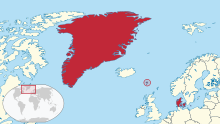 Kingdom of Denmark in its region (special marker) | |
| Total population | |
|---|---|
| 18,563[1] | |
| Regions with significant populations | |
| Copenhagen, Odense, Aalborg, Aarhus, Frederiksberg | |
| Languages | |
| Greenlandic, Danish | |
| Religion | |
| Predominantly Lutheran See Religion in Denmark | |
| Related ethnic groups | |
| Greenlanders, Danes, Danish Greenlanders, Greenlandic Americans, Danish Americans, Danish Canadians, Danish Australian, Scandinavian Americans, European Americans Other Inuit ethnic groups |

Greenlandic people in Denmark (Danish: Grønlændere i Danmark; also known as Greenlandic Danes) are residents of Denmark with Greenlandic or Greenlandic Inuit heritage. According to StatBank Greenland, as of 2020, there were 16,780 people born in Greenland living in Denmark, a figure representing almost one third of the population of Greenland.[2][3] According to a 2007 Danish government report, there were 18,563 Greenlandic people living in Denmark.[1][4] The exact number is difficult to calculate because of the lack of differentiation between Greenlandic and Danish heritage in Danish government records and also due to the fact that the way in which people identify themselves is not always a reflection of their birthplace.[5][6][7] As of 2018, there were 2,507 Greenlanders enrolled in education in Denmark.[2]
Greenlanders have Danish citizenship as Greenland is an autonomous territory of the Kingdom of Denmark.[8] This means they are entitled to the same privileges as ethnic Danes but also that Greenlanders miss out on services extended to newly arrived immigrants in Denmark.[9][5] Greenlandic people are not recognised as an ethnic minority in Denmark.[8]
Greenlandic people in Denmark experience higher rates of unemployment, poverty, homelessness and substance abuse than ethnic Danes.[10] There are also high levels of prejudice and discrimination reported by Greenlanders living in Denmark.[10] As per the COE recommendations, the Danish government has recognised the need to improve the situation of Greenlandic Danes.[11]
- ^ a b "Grønlændere bosiddende i Danmark (Danish)" (PDF). Statistics Denmark. 2018. Retrieved July 22, 2018.
- ^ a b "Persons born in Greenland living in Denmark by gender, age, socioeconomic status, affiliation and time". StatBank. Retrieved 2021-04-23.
- ^ "BEF5G: PEOPLE BORN IN GREENLAND AND LIVING IN DENMARK 1. JANUARY BY SEX, AGE AND PARENTS PLACE OF BIRTH" (in Danish and English). Statistics Denmark. 30 August 2006. Retrieved 23 August 2018.
- ^ Kalaallit Danmarkimi Najugallit. (2007). Grønlændere Bosiddende i Danmark. http://www.udsattegroenlaendere.dk/wp-content/uploads/dnag-groenlaendere-20i-20danmark-201-1.pdf
- ^ a b "Greenlanders in Denmark: a Realistic Perspective of a Varied Group". Humanity in Action. Retrieved 2021-03-29.
- ^ Flora, Janne (2018). "Different from all the "Others": Mobility and Independence among Greenlandic Students in Denmark". Arctic Anthropology. 54 (2): 71–82. doi:10.3368/aa.54.2.71. S2CID 165576340.
- ^ Danish Institute for Human Rights (2015). "Parallel Report to the Un Committee on the Elimination of Racial Discrimination on the 20th and 21st Periodic Reports by the Government of Denmark on the Implementation of the International Convention on the Elimination of All Forms of Racial Discrimination" (PDF). Archived from the original (PDF) on 2021-05-25. Retrieved 2021-05-25 – via Office of the United Nations High Commissioner for Human Rights.
- ^ a b "Equal treatment of Greenlanders in Denmark | The Danish Institute for Human Rights". www.humanrights.dk. Retrieved 2021-05-25.
- ^ "Murmur » Neglected and invisible – Life as a Greenlander in Denmark". Archived from the original on 2022-01-21. Retrieved 2021-03-23.
- ^ a b "Greenlanders in Denmark voice their concerns to UN Special Rapporteur - IWGIA - International Work Group for Indigenous Affairs". www.iwgia.org. Archived from the original on 2023-01-31. Retrieved 2021-03-29.
- ^ "ECRI REPORT ON DENMARK (fifth monitoring cycle)". European Council Against Racism and Intolerance (ECRI). 2017 – via Council of Europe.